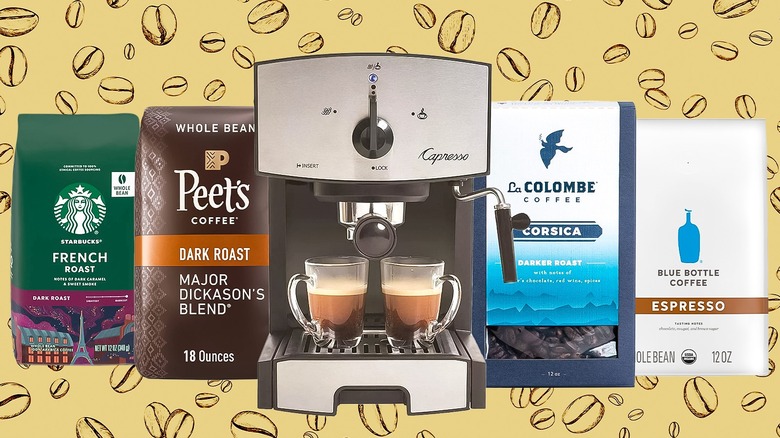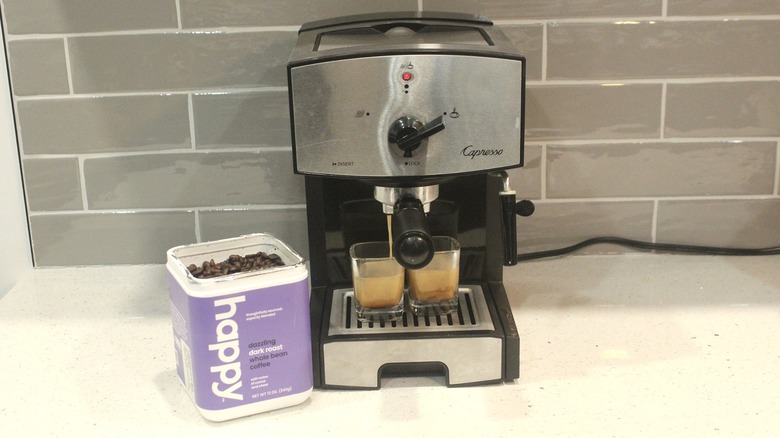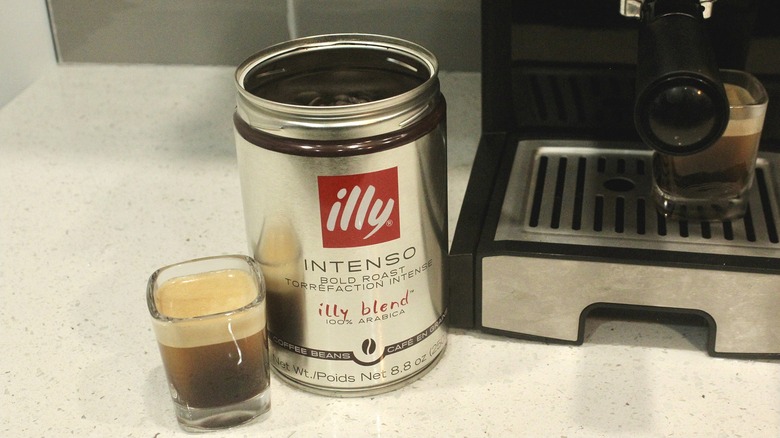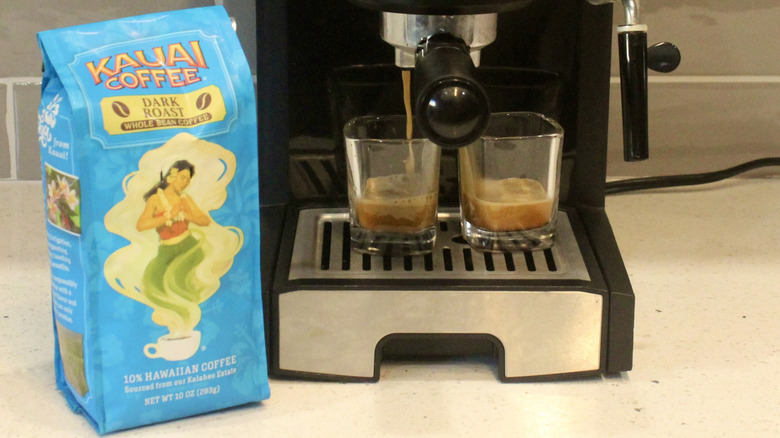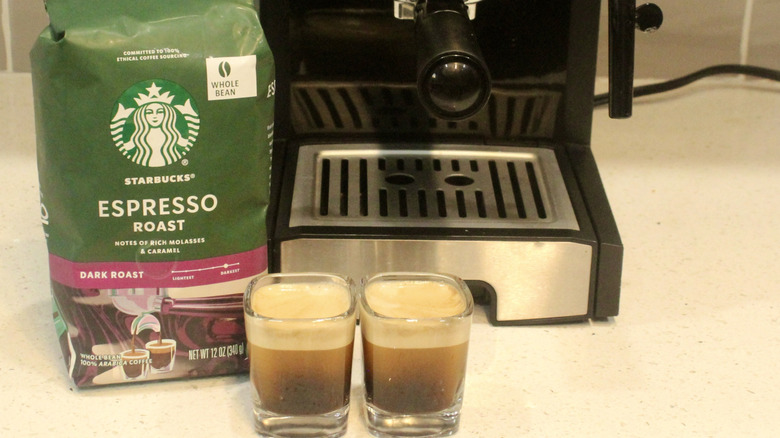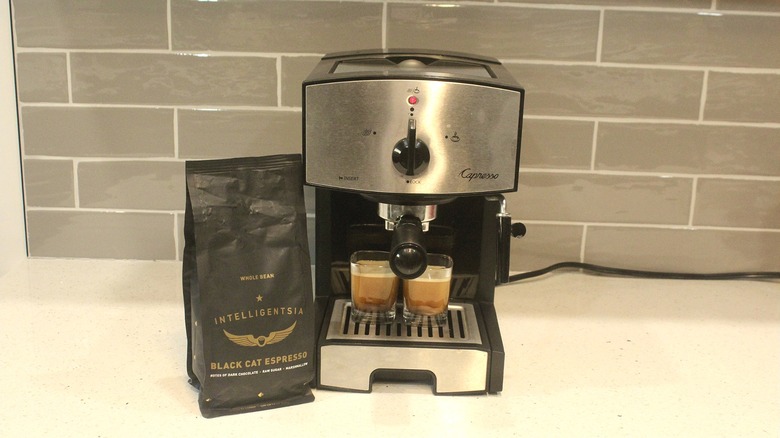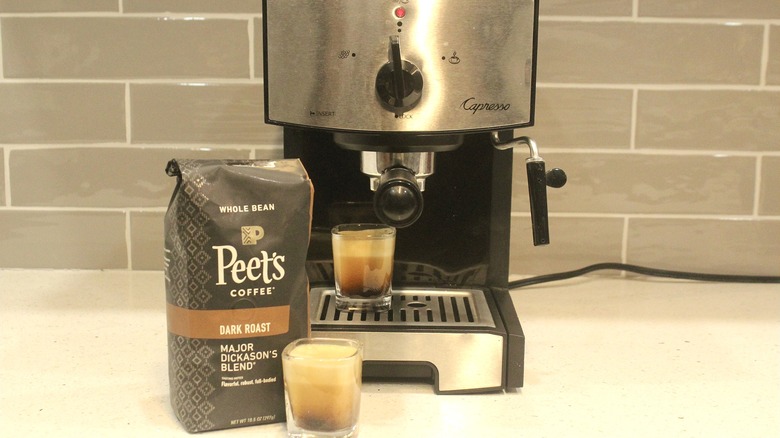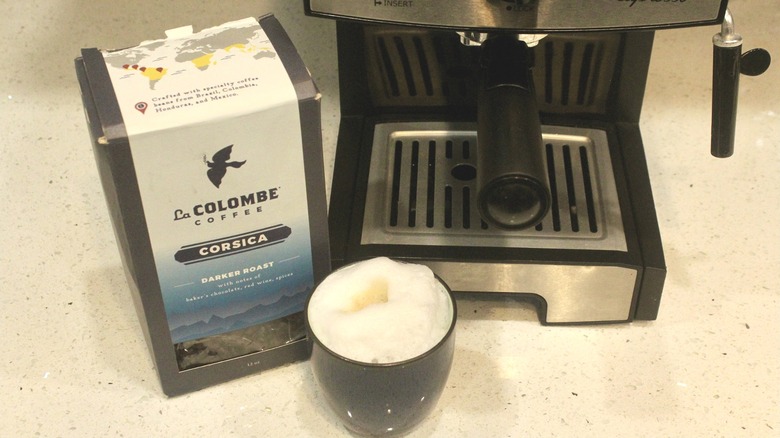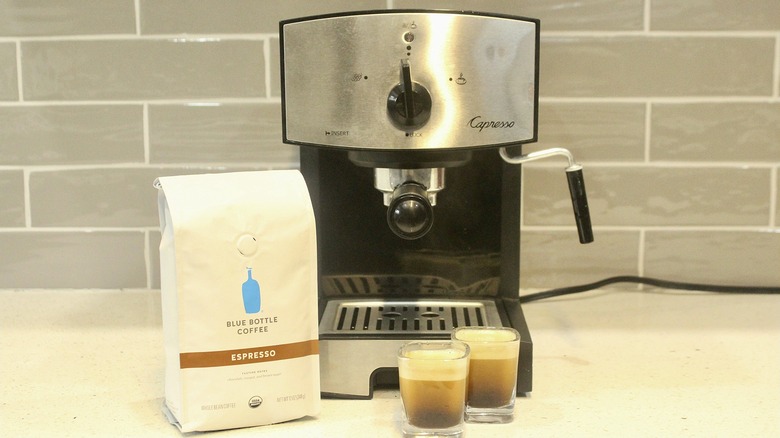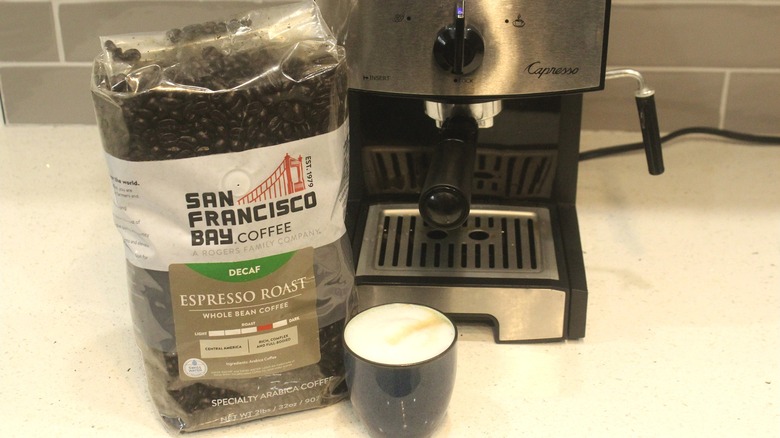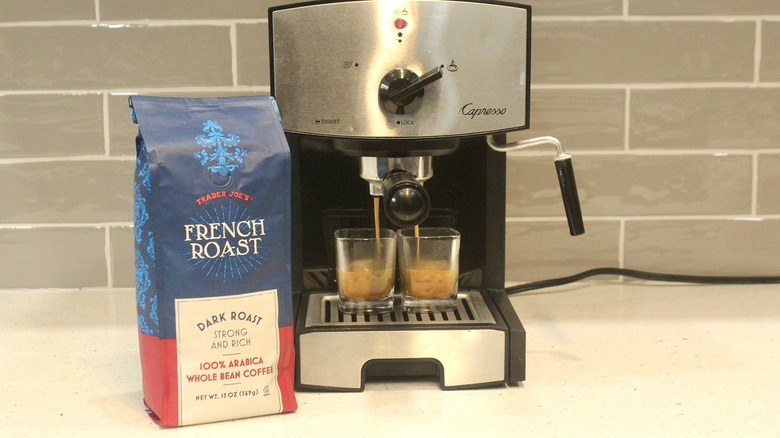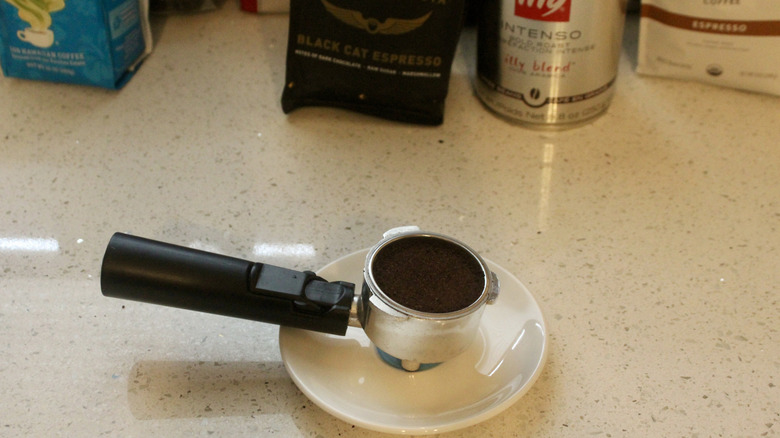We Tried 10 Popular Coffee Brands To Find Out Which Works Best For An Espresso Machine
We may receive a commission on purchases made from links.
If you've invested in an at-home espresso machine, you're already aware of the many perks that come along with it. Now that you're liberated from obligatory cafe lines, overpriced lattes, and the need to explain the carefully plotted customizations of your drink order, it's time to buy some espresso beans. This sheer number of coffee brands out there can be a little overwhelming. So I went out there on your behalf. To figure out which coffees make good espresso shots, I gave some popular brands a try.
Bags labeled "espresso" are a good place to start when trying to find a brand you like, but other roasts can also be used in your machine. Keep in mind that achieving the strong, bitter yet balanced taste of a good espresso shot means you'll need darker, full-bodied beans — blondes and other light roasts won't work as well here. Every coffee I tried was tasted as a plain espresso shot first, then as a single-shot macchiato. Stay tuned for more details about the methodology behind the taste test at the end of the article.
Knowing which beans are compatible with your espresso machine is the foundation upon which you can sharpen your barista skills and make traditional café drinks that dazzle your family, friends, and yourself. I ran brands of coffee through my espresso machine to find the ones that performed best under (literal) pressure and which ones were a bit of a buzzkill. Here's how it went.
Happy Dazzling Dark Roast
I kicked off the coffee taste test with Happy Dazzling Dark Roast, purchased on Amazon for just under $12. Happy coffee is co-owned by Robert Downey Jr. and Craig Dubitsky who launched the brand in January 2024. Happy Dazzling Dark Roast isn't marketed as an espresso, but it plays the part exceptionally well. In preparation, I ground the whole beans to a fine consistency (the standard grind that espresso machines call for) then manually packed them into the machine's portafilter. As the double shot poured, the beans produced a caramel colored espresso. There was a good amount of crema at the top of each espresso shot glass which is always appetizing.
Sipping the espresso was honestly a treat. It really tasted like the kind of drink you would order at a café and be satisfied with. What stood out about Happy Dazzling Dark Roast was its smoothness. It's strong but not overtly powerful. The taste is well-balanced and is well thought out.
As a final measure, I poured a single shot over steamed 1% milk inside a 6-ounce glass to see how it fared as an espresso macchiato. Again, it showed off its balance, melding with the milk in a way that didn't shrink nor compete. All in all, Happy set the bar high. You know what else makes me happy? Downey Jr. and Dubitsky's coffee partners with the National Alliance on Mental Illness to provide support and awareness to those affected by mental health issues.
Illy Intenso Bold Roast Coffee Beans
When it comes to world renowned coffee brands, illy is getting it right. There are brick and mortar stores, a recognizable logo, and of course, reputable coffee beans. When I picked up a classy cylinder of illy Intenso Bold Roast coffee beans (which will run you around $11.99 for an 8.8-ounce can) and ground them for my espresso machine, I knew that there was no way they could be bad. That's the power of brand trust I guess.
Intenso Bold Roast was definitely not bad as espresso, but they weren't exactly "intenso" either. One sip of the espresso shot was all it took to bring the acidity of these beans to the forefront. A bonafide depth of flavor or at least some flavor complexity could have anchored the acidity these espresso shots presented, but it wasn't quite there.
Pouring a shot of illy Intenso Bold Roast espresso into steamed milk to make a single shot macchiato toned the sharp, acidic notes down immediately. To this end, this offering from illy would work for espresso drinkers who plan on primarily using shots to make lattes, cappuccinos, or other café drinks that require milk. On a separate occasion, I brewed this roast as a percolated coffee and added a little light cream. In percolated form, illy Inteso is a lovely way to start the day.
Kauai Dark Roast Coffee
The belief that espresso beans are the only ones suitable for an espresso machine is one of coffee's many myths, and something I was hoping Kauai Dark Roast Coffee would help disprove. First impressions hold weight, and the look of Kauai Dark Roast's vibrant blue bag along with the allure of Hawaii's signature Kona coffee sustained my anticipation. Upon opening the fresh bag, which typically sells for under $10, I got my nose close and breathed in deeply, eager to take in the deep aroma of beans grown amongst volcanic soil in the Aloha state. I was underwhelmed (it's only 10% Hawaiian coffee after all).
Shaky first impressions aside, I tamped the grounds into the portafilter and pulled the double shot. The color and the crema that developed looked very espresso-like, and all that was left to do was drink it. Kauai's generally weak flavor left it vulnerable to criticisms. The lack of boldness drew attention to the coffee's medium acidity — something that works better when brewing in a percolator or a pour-over coffee maker. As an espresso shot, Kauai's acidity brought out the muddiness in its flavor and flattened out the finish.
Pairing coffee with milk is a surefire way to mellow its acidity, which is exactly what happened when I sipped Kauai's offering as an espresso macchiato. In this form, there was nothing harsh about it. On the contrary, steamed milk made Kauai as espresso shrink into something forgettable.
Starbucks Espresso Roast
As far as popular store-bought coffee brands go, Starbucks, which happens to be the second largest restaurant chain on earth, has had a foothold in the retail game for ages. Starbucks Espresso Roast is an obvious choice when looking for a coffee that will work with your espresso machine — it's the same roast that goes into espresso drinks made at Starbucks café locations. Starbucks Espresso Roast is available in most chain supermarkets, I was able to find a 12-ounce bag at Target for $9.79.
The look and aroma of these beans fulfill those quintessential notions we have of espresso. They are dark and a little oily, with a strong, deeply-roasted smell. Espresso Roast can be brewed in a percolator, pour-over, or other coffee machine, but when I made espresso shots with these beans I really felt like I was using them for their intended purpose. The espresso had a strong, earthy flavor and left no trace of bitterness in the aftertaste. The shot tasted well-balanced and the crema at the top of the glass was picture perfect.
If I had to fault Starbucks Espresso Roast, I would say that it's a little predictable. The overall flavor doesn't push boundaries in terms of complexity, relying instead on a boldness that is more straightforward. Starbucks might be playing it safe with Espresso Roast, but after all these years, it's still a reliable coffee with a genuine espresso taste.
Intelligentsia Medium Black Cat Espresso
I was lucky to snag a bag of Intelligentsia's Black Cat Analog Medium Espresso from Amazon on sale for a little under $9. The typical range for a 12-ounce bag is between $11.87 and $16.49, but, hey, it's specialty, fair-trade coffee. On the sleek black packaging, Intelligentsia indicates that its medium espresso contains notes of dark chocolate, raw sugar, and marshmallow. While I was skeptical, I still felt eager to try it.
Opening the bag brought forth that fragrant earthy coffee bean scent I love. Inside were light brown beans characteristic of medium and light roast coffee. Also, the beans were smaller than average in size. Some small beans pack a big punch, but generally speaking, you'll need to add more of them into the grinder so that the grounds fill your espresso machine's portafilter (such was the case with Medium Black Cat Espresso). Once ground, the beans appeared amber brown in color with little flecks of yellow — a characteristic seen in most lighter coffees.
With every attribute of Intelligentsia's Medium Black Cat Espresso, embodying those of a true medium roast, it was no surprise that the espresso shots had high acidity. Perhaps it's a personal preference, but I just don't find coffee that can be described as "crisp" or "bright" the best choice for making espresso. As I suspected, those dark chocolate or marshmallow-y notes described on the bag didn't come through.
Peet's Coffee Major Dickason's Blend
On a personal note, I've drank Peet's Major Dickason's Blend for years — but only as brewed coffee. What drew me to Major Dickason's Blend year after year was its unequivocal boldness, but I never thought to make it my go-to espresso. Another attractive quality of Peet's Major Dickason's Blend is its price point. At $11.89 a bag at Target, it's affordable compared to many other popular dark roast coffees on the market.
In the espresso machine, Major Dickason's Blend behaved the way any good espresso roast would. The shots developed a warm brown color and were topped with plenty of crema. The espresso shot was palatable, flourishing with deep, strong flavor and a pinch of acidity in the finish. Some dark roast coffees reach a similar boldness in taste but flatten out in terms of complexity.
Major Dickason's Blend on the other hand, achieves a roundness in flavor that rolls over the palette. The notes of earthiness are subtle yet impactful and end with a bitterness that smacks of intentionality, as opposed to an inevitable afterthought. Dropped into a helping of steamed milk to make an espresso macchiato doesn't strip the boldness of the flavor away. Major Dickason's Blend is a great choice for making espresso, milk or not.
La Colombe Corsica Darker Roast
One of the first things that struck me about La Colombe was its unique and intentional packaging. La Colombe's Corsica Darker Roast beans are housed in a deep blue cardboard box that gives way to a clear plastic sheath complete with a valve to let carbon dioxide out without allowing oxygen in. This effort to retain the coffee's freshness paid off. The beans had a well-preserved moistness and enticing aroma that makes them well-suited to an espresso machine.
Corsica, the Mediterranean island off the southern coast of France, is better known as the birthplace of Napoleon than for its coffee beans. Despite the name, La Colombe's beans aren't European in origin, they're sourced from Brazil, Colombia, Honduras, and Mexico. Ambiguities in nomenclature aside, this coffee worked wonderfully in my espresso machine. The taste was unapologetically robust and carried a hint of acidity. The well rounded flavor thwarted away any sense of unappealing bitterness. In short, it just tasted good.
What I liked about La Colombe Corsica Darker Roast was that it had personality. It was different from your run-of-the-mill bold roast espresso because of the complexity it displayed. It made for lovely drinking as a straight espresso shot, so I was eager to see how it came across when added to steamed milk. As an espresso macchiato it also excelled. Making it a double espresso macchiato was even better. For $12.89 a bag at Target, these beans makes espresso sing.
Blue Bottle Espresso Roast
Blue Bottle is a darling of the specialty coffee industry, with cafés throughout the U.S. and Asia. I've only tried Blue Bottle once, as a medium roast canned coffee that I found harshly acidic. Since then, I have wanted to try one of the brand's darker roasts. I got my chance when I found a 12-ounce bag of Blue Bottle Espresso on Amazon for $14.48 (on sale, the price can dip below $14). Espresso beans for an espresso machine is about as uncomplicated as it comes.
Blue Bottle espresso beans are deep brown in color, slightly oily, and smell great. The beans produced a caramel brown espresso with a good amount of crema. Crema is the froth that forms on espresso shots. It's created by small carbon dioxide bubbles that develop as pressurized hot water moves through the tightly packed grounds in the portafilter. The bubbles bond to the coffee's natural oils, creating a creamy layer that floats to the top of the shot.
Upon first sip, I noted fullness in the espresso's body, but was hit with an acidic aftertaste straightaway. I've come to understand that acidity levels in coffee are ultimately a matter of taste and I am not usually a fan. When I think of espresso shots I crave dark, luxuriant coffee. Blue Bottle didn't check that box. Pouring the espresso over steamed milk helped the flavor profile feel more complete, more fully-realized. Overall, Blue Bottle Espresso doesn't go bold enough.
San Francisco Bay Decaf Espresso Roast
It's easy to say death to decaf — until you're forced to switch to the dreaded, almost 100% caffeine-free alternative. While I am technically allowed to have caffeinated coffee, my daily morning routine consists of one or two cups of half-caf for health reasons. That's why I keep (a big bag) of decaf espresso in my possession at all times. San Francisco Bay Decaf Espresso Roast gets the job done in my percolator, but I've never actually made espresso with it, until now.
San Francisco Bay coffee has been around since 1979, and it can be found in grocery stores and online. You can find a 2-pound bag of San Francisco Bay Decaf Espresso Roast on Amazon for $21.99 (other roasts from the brand are sold at a similar price point). My first time drinking San Francisco Bay Decaf Espresso Roast was a pleasant experience. The winning attribute of this espresso is its smoothness. Beyond that, this decaf espresso roast gets the job done and not much more.
The lack of flavor complexity flattens out the taste, so by the fourth sip it becomes rather dull. I'm not aware of anyone who drinks decaf espresso straight up — though I'm sure they're out there — so I turned a single shot into a macchiato. Some steamed low-fat milk complemented the espresso well, and this simple addition elevated San Francisco Bay Decaf Espresso Roast's potential. Non-caffeine drinkers would certainly appreciate a homemade latte made with these beans.
Trader Joe's French Roast
At just $6.99 for 13 ounces of beans, Trader Joe's French Roast is something of a triumph. I really appreciate when the description on a product's packaging is accurate to the real thing, this was. Trader Joe's French Roast is labeled as a dark roast that is strong and rich. What I sipped from the espresso glass was exactly that. The robust flavor melded beautifully with the rich, bountiful crema atop the espresso shots.
There was a bitter edge to the finish of the French Roast as espresso, but it didn't come off as a detriment to the coffee's fullness of flavor. The frothiness of the crema on top, followed by the punchy dark notes of the espresso that was finished by a bitter touch at the end gave Trader Joe's French Roast a layered complexity that other coffee brands in the taste test lacked. This espresso wasn't perfect, but it was interesting.
I was confident that pouring a shot over steamed milk would tone down the bitterness of the aftertaste, and sure enough it did. A coffee that works well as an espresso won't lose the nuances of its flavor once it's combined with milk. Trader Joe's French Roast held its own in the macchiato. If you primarily use your espresso machine to make milk-based drinks like lattes or cappuccinos, this French Roast would be a good option.
Methodology
This taste test was centered around "popular coffees," which I translated as coffee brands one could easily find at the local grocery store or an online marketplace like Amazon. As a longtime certified barista, I recommend using dark roast coffees in an espresso machine. Their bolder flavor can better withstand the pressure from hot water in the machine forcing through the grounds packed into the portafilter. I also suggest using whole bean coffee and grinding it immediately before use. This helps prevent your espresso shots from tasting stale. All of the coffees used in this taste test were purchased in whole bean form.
I used an electric grinder to finely ground the coffees. I tamped the grounds into the portafilter of my manual Capresso 117 EC50 stainless steel espresso machine that's about 10 years old. Fancy? No. Reliable? Yes (though moka pots can be reliable, too). For the tasting, I pulled a double shot of each coffee, drank the espresso straight from the glass it was made in, then added one shot to steamed 1% milk in a six ounce mug. This allowed me to gauge how the espresso's flavor notes potentially changed when paired with dairy.
The best espresso shots are full-bodied in taste and well-balanced. Coffee brands that exhibited depth of flavor and had a clean finish were considered good candidates for an espresso machine. Coffees that tasted weak, acidic, or overly bitter didn't get my seal of approval as espresso, but they may still work well inside a percolator or another brewing machine.
My personal favorite brand to use in the espresso machine out of the ones tested was La Colombe Corsica Darker Roast, though Peet's was close to beating it. And an honorable mention goes to Happy, which made my taste buds very happy.
